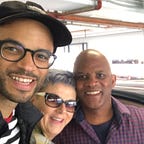Black lives and street trees
The branches are swaying above the Clinton Street apartments. Above the Clemente Cultural Center. Above the Catholic Church. It’s Sunday morning in the Lower East Side. A time for coffee and pancakes and maybe prayer or stillness.
But the branches are not still. The American Elm, the Black Locust, the American Sycamore. From here, I can only see their canopies, but I know who they are. And I know what they have seen.
They are street trees, and yesterday they saw what the streets can do. They saw how the streets could handcuff a journalist in a black jacket and lock him in the back of an-all white van. How the streets could throw a woman in braids and a pink pullover on to her head and into a seizure. How the streets could run entire groups of college students over in their NYPD SUVs. The trees have seen this. And they are not silent. They are not still.
They are street trees. Born in a nursery in upstate, or Massachusetts, or Vermont, or maybe even California. And then planted in the harsh soil of the Lower East Side, or Brooklyn, or Union Square. Some of them didn’t make it: some of them didn’t survive the journey, or the first winter, or that harsh summer, or the millions of feet walking across them, or the semi-trucks laying concrete over their roots. But many did.
As adolescents, they began to hear the stories of their family in the forest, miles away, traveling through the organic compounds carried by the wind. From Wawayanda and Wilowemoc and Minnewaska. The young street trees longed for them. But they also decided to be content, to live their best life amongst the people. Amongst the streets.
They grew into young adults. Inch by inch, ring by ring: they spread their branches out over cars and fruit carts, stretched their trunks over kindergartens and corner stores. They became street trees, knowing they would never reach the age or heights that they knew they could in the forest. But knowing they could still be happy.
Happy to house the pigeons and doves and starlings and squirrels. Happy to feed the bees and wasps and caterpillars. Happy to shade the park bench newspaper readers and canvas-oil painters and Sunday morning coffee drinkers.
Until some of their favorite starlings stopped showing up. And some of their favorite bees could never be found. And some of their favorite oil painters and coffee drinks and newspaper readers started disappearing. Inside coffins made of some of their favorite trees, who had also disappeared. Not unlike George Floyd, Breonna Taylor, Ahmaud Arbery, Tony McDade, Dion Johnson.
Now the swaying street trees, who grew from the dirt and the concrete and the sidewalks and the corners, are tired. Not unlike my black and brown brothers and sisters. Not unlike me. Perhaps not unlike you.
They are tired, even though they are still not that old. Their drooping branches look tired, and their rough bark feels tired, and their leaves singing in the night even sound tired. Their trunks sway back and forth, and their green canopies play the same blue notes, and their faded flowers drop into the same sidewalk cracks and gutters. Because they no longer know what else to do.
They only know that they grew to love their streets. And that their streets grew to love them. But that their streets are not their streets, anymore.
